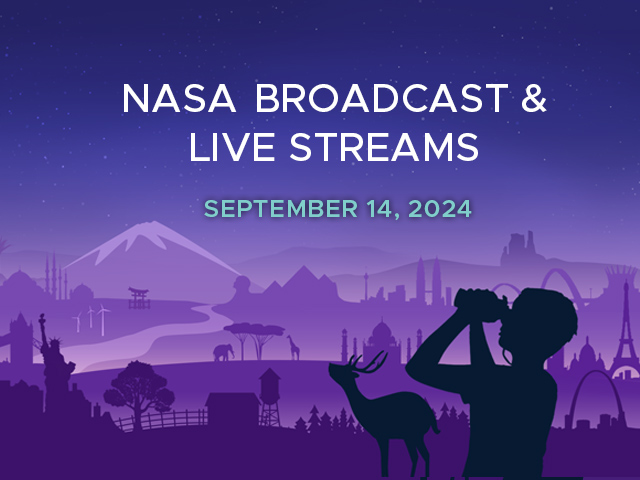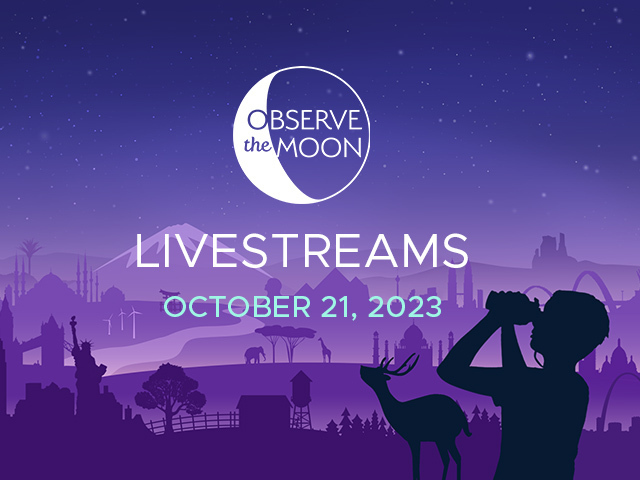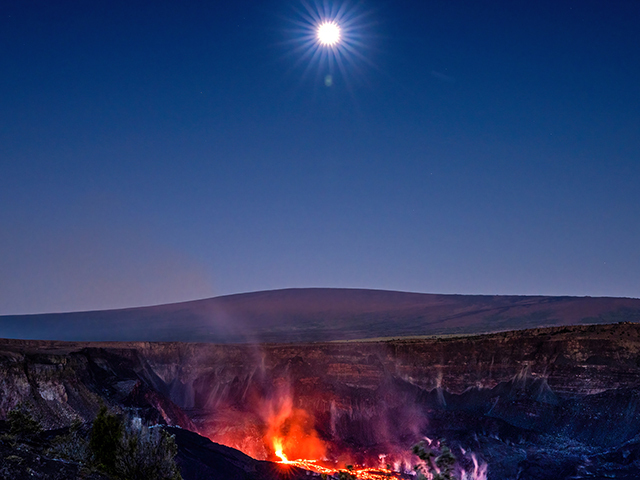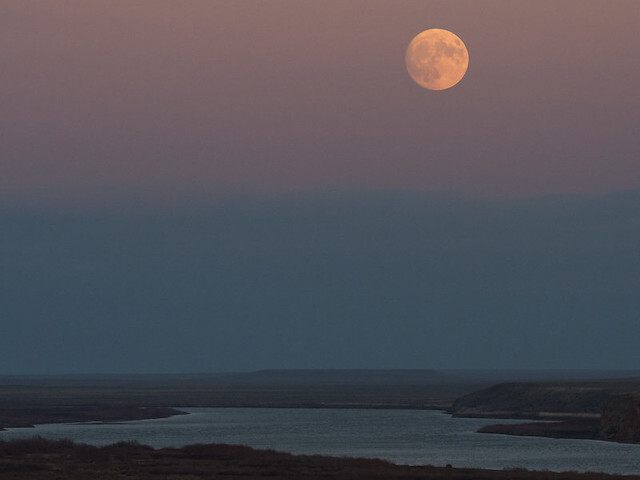News | November 30, 2017
Moon Missive: the Next Full Moon is the Frost Moon, the Moon Before Yule, and a Supermoon
The next full Moon will be Sunday morning, Dec. 3, 2017, appearing "opposite" the Sun (in Earth-based longitude) at 10:47 AM EST. The Moon will appear full for about three days centered on this time, from later on Friday night through early Monday evening, making this another full Moon weekend.
As the last full Moon of Autumn, this Moon is known as the Frost Moon or the Moon Before Yule. The Maine Farmer's Almanac first published Indian names for the full Moons in the 1930's, and according to this almanac, the Native American name for this full Moon was the Frost Moon, as frosts began to occur at the end of Fall. Europeans called this the "Moon before Yule" (Yule is an old northern European winter festival that is now associated with Christmas).
Since this full Moon occurs about 17 hours before perigee (the Moon's closest approach to the Earth in its orbit), this full Moon is the first of three supermoons. At the time of the full Moon, the Moon will be will only be 492 km (306 miles) further away from the Earth than it will be at its closest (perigee), making it appear 13.6% larger in diameter and 29% larger in area than if it were the distance of apogee on December 18, 2017. In addition, because the Earth will be at its closest to the Sun (called perihelion) in early January, the sunlight reaching and reflecting off the Moon this time of year is about 7% more intense (than at aphelion in early July), making winter-time supermoons even brighter.
In lunisolar calendars the months change with the new Moon and full Moons fall in the middle of the lunar months. This full Moon is the middle of the tenth month of the Chinese calendar, Kislev (sometimes known as the month of dreams) in the Hebrew calendar (Hanukkah starts on the 25th day of Kislev), and Margashirsha in the Hindu calendar. The day of the full Moon (Purnima) in Margashirsha is the holy day Datta Jayanti, also known as Dattatreya Jayanti, commemorating the birth day of the Hindu god Dattatreya (Datta). For more information see https://en.wikipedia.org/wiki/Datta_Jayanti
In the Islamic calendar the months start with the first sighting of the waxing crescent Moon a few days after the New Moon. This full Moon is near the middle of Rabi' al-awwal, the third month of the calendar. In this month most Muslims celebrate Mawlid, the birthday of the prophet Muhammad, although different denominations celebrate different days of the month.
As usual, the wearing of suitably celebratory celestial attire is encouraged in honor of the full Moon.
As for other celestial events between now and the full Moon after next:
As Autumn ends and Winter begins, the daily periods of sunlight are short, with the shortest on the day of the northern hemisphere winter solstice. The length of a day (as measured for example from noon to noon on a sundial) varies through the year. Around the solstices, although the period of daylight is short, the length of a solar day is slightly longer than the 24 hour average. Because of this offset in the length of the solar day, the earliest sunsets of the year occur before the winter solstice, and the latest sunrises of the year (ignoring Daylight Savings Time) occur after the winter solstice.
For the Washington, DC area, the earliest sunsets will occur on the 12 days from Friday, December 1, 2017 through Tuesday, December 12, 2017 (rounded to the minute, sunset will be at 4:46 PM EST across these dates). On the day of the December full Moon, Sunday, December 3, 2017, morning twilight will begin at 6:07 AM, sunrise will be at 7:10 AM, the Sun will reach a maximum altitude of 28.9 degrees at 11:58 AM, sunset will be one of these earliest sunsets of the year at 4:46 PM, and evening twilight will end at 5:49 PM EST. On the day of the Winter Solstice, Thursday, December 21, 2017, the day with the shortest period of daylight of the year, morning twilight will begin at 6:20 AM, sunrise will be at 7:23 AM, the Sun will reach a maximum altitude of 27.7 degrees at 12:06 PM, sunset will be at 4:50 PM, and evening twilight will end at 5:53 PM EST. Ignoring Daylights Savings Time, the latest sunrises of the year will occur on the 10 days from Sunday, December 31, 2017 through Tuesday, January 9, 2018 (rounded to the minute, sunrise will be at 7:27 AM EST across these dates). On the day of the January full Moon, Monday, January 1, 2018, morning twilight will begin at 6:24 AM, sunrise will be one of these latest sunrises at 7:27 AM, the Sun will reach a maximum altitude of 28.2 degrees at 12:12 PM, sunset will already be getting noticeably later at 4:57 PM, and evening twilight will end at 6:00 PM EST.
On the evening of the December full Moon, as evening twilight ends, the planets Mercury and Saturn will be setting in the south-southwest, only about 2 degrees apart. If you want to see them, the best time to look would be about 30 minutes after sunset, and you will need a clear view of the horizon. The trio of bright stars called the "Summer Triangle" will appear high in the west. The "Summer Triangle" is not a constellation but consists of the three brightest stars from three different constellations. Closest to overhead will be Deneb, the brightest star in the constellation Cygnus the Swan; to the west-northwest will be Vega, the brightest star in the constellation Lyra the Harp; and to the south-southwest will be Altair, the brightest star in the constellation Aquila the Eagle. If you are lucky enough to live in an area where it is dark enough to see the Milky Way, our home galaxy will appear stretched nearly overhead from west-southwest to east-northeast. Over the coming days Mercury and Saturn will appear to shift closer to the Sun, setting earlier and becoming lost from view. Mercury will pass between the Earth and Sun on December 12 and Saturn will pass beyond the Sun as seen from Earth on December 21, 2017. By the evening of the first full Moon in January, as evening twilight ends, the bright stars of the local arm of our home galaxy, including the constellation Orion, will be rising in the east.
On the morning of the December full Moon, as morning twilight begins, the planet Mars and the bright star Spica will appear near each other in the southeast about 28 degrees above the horizon. The bright planet Jupiter will appear to the lower left of Mars and Spica, about 15 degrees above the horizon. The bright stars of the local arm of our galaxy (including the constellation Orion) will be setting in the west-southwest. As December progresses, the planet Mercury will emerge from the glow of dawn in the east-southeast (having passed between the Earth and the Sun on December 12, 2017). As a thin crescent, Mercury will be difficult to see at first. By the time of the next full Moon in early January, as morning twilight begins, the bright stars of the local arm of the galaxy will have set, Mars and Jupiter will appear near each other about 30 degrees above the horizon in the southeast, and Mercury will appear about 7 degrees above the horizon in the east-southeast.
Likely the best meteor shower of 2017, the annual Geminid meteor shower, caused from debris from the comet 3200 Phaethon hitting the Earth's atmosphere at 35 km/sec (78,000 miles per hour), will be active from about December 4 to about December 16, 2017, peaking the night of December 13 and early in the morning on December 14, 2017. At its peak, if you have a very clear sky and are far away from city lights, you should be able to see about 120 meteors per hour, and unlike last year, most of the night will be free from interference from moonlight.
The annual Ursid meteor shower is not expected to produce many visible meteors this year (about 10 per hour). The good news is that the waxing crescent Moon will not interfere, as it will set by around 9 PM. This meteor shower will be active from around December 17 to 24, 2017, peaking early in the morning of December 22, 2017, and is caused by debris from the comet 8P/Tuttle hitting the Earth's atmosphere at 33 km/sec (74,000 miles per hour).
The annual Quadrantid meteor shower is another usually strong meteor shower, active from December 28, 2017 to January 12, 2018, but peaks two days after the full Moon after next (at the start of January), so moonlight will interfere with observing these meteors.
Even though they are not visible usually, I include in these Moon missives information about Near Earth Objects (mostly asteroids) that pass the Earth within about 10 lunar distances, because I find it interesting that we have discovered so many. On Saturday morning, December 2, 2017 at 6:52 AM EST (2017-Dec-02 11:52 UTC), Near Earth Object (2008 WM61), between 12 and 27 meters (40 to 89 feet) in diameter, will pass the Earth at 3.7 lunar distances, traveling at 4.70 kilometers per second (10,518 miles per hour).
Saturday evening into Sunday morning, December 2 to 3, 2017, the bright star Aldebaran will appear near the full Moon.
As mentioned above, the next full Moon will be on Sunday, December 3, 2017, at 10:47 AM EST. Because this full Moon is near perigee, it qualifies as the first of three supermoons.
Monday, December 4, 2017, at 3:42 AM EST, the Moon will be at perigee, its closest to the Earth for this orbit. At 357,492 km (222,135 miles), the Moon will be 12% closer than it was at apogee earlier in November.
On Tuesday morning, December 5, 2017 at 8:36 AM EST (2017-Dec-05 13:36 UTC), Near Earth Object (2017 WS13), between 32 and 71 meters (105 to 234 feet) in diameter, will pass the Earth at between 9.3 and 9.6 lunar distances (nominally 9.4), traveling at 11.30 kilometers per second (25,281 miles per hour).
On Friday morning, December 8, 2017, the bright star to the left of the waning gibbous Moon will be Regulus. We will not be able to see the Moon when it passes in front of Regulus Friday afternoon, but Regulus will appear to the upper right of the Moon when the Moon rises Friday evening (at 10:38 PM EST for the Washington, DC area). The Moon will appear to move away from Regulus Friday night into Saturday morning.
On Saturday afternoon, December 9, 2017 at about 4:47 PM EST (2017-Dec-09 21:47 UTC with 8 minutes uncertainty), Near Earth Object (2017 WV12), between 19 and 43 meters (63 to 141 feet) in diameter, will pass the Earth at between 3.4 and 3.5 lunar distances (nominally 3.4), traveling at 10.62 kilometers per second (23,757 miles per hour).
Sunday morning, December 10, 2017, the waning Moon will appear half-full as it reaches its last quarter at 2:51 AM EST.
Tuesday evening, December 12, 2017, will be when the planet Mercury will pass between the Earth and the Sun, called inferior conjunction.
Wednesday morning, December 13, 2017, the planet Mars and the bright star Spica will appear to form a triangle with the waning crescent Moon, with Spica on the right and Mars below the Moon. The bright planet below the triangle will be Jupiter. For the Washington, DC area, Spica will rise at 2:39 AM, the Moon will rise at 2:45 AM, and Mars will rise at 3:16 AM EST. This triangle will be visible until lost in the glow of morning twilight, which will begin at 6:15 AM.
On Wednesday evening, December 13, 2017 at 7:07 PM EST (2017-Dec-14 00:07 UTC), Near Earth Object (2015 XX169), between 8 and 19 meters (28 to 62 feet) in diameter, will pass the Earth at 9.7 lunar distances, traveling at 6.25 kilometers per second (13,981 miles per hour).
The annual Geminid meteor shower is expected to peak late Wednesday night, December 13, into the morning on Thursday, December 14, 2017. The Geminids are caused from debris from the comet 3200 Phaethon hitting the Earth's atmosphere at 35 km/sec (78,000 miles per hour). At the peak, if you have a very clear sky and are far away from city lights, you should be able to see about 120 meteors per hour, and unlike last year, most of the night will be free from interference by moonlight. The best time to look will be after midnight but before the sky starts to lighten, first from moonrise (although the thin crescent Moon will not interfere too much, and will be putting on a show with Mars and Jupiter as noted below), then with dawn. For the Washington, DC area, moonrise will be at 3:43 AM and nautical twilight will begin around 6:16 AM EST.
Thursday morning, December 14, 2017, the planets Mars and Jupiter will appear to form a triangle with the waning crescent Moon, with Mars to the upper right and Jupiter to the lower right. The bright star to the upper right of Mars will be Spica. For the Washington, DC area, Mars will rise at 3:15 AM, the Moon will rise at 3:43 AM, and Jupiter will rise at 4:08 AM EST. This triangle will be visible until lost in the glow of morning twilight, which will begin at 6:16 AM. If you are out to see this triangle, also watch for meteors (as noted in the entry above).
On Thursday morning, December 14, 2017 at 7:50 AM EST (2017-Dec-14 12:50 UTC), Near Earth Object (2006 XY), between 42 and 94 meters (138 to 309 feet) in diameter, will pass the Earth at 3.3 lunar distances, traveling at 4.88 kilometers per second (10,913 miles per hour).
On Saturday evening, December 16, 2017 at about 9 PM EST (2017-Dec-17 01:58 UTC with 40 minutes uncertainty), Near Earth Object (2017 VT14), between 77 and 171 meters (252 to 562 feet) in diameter, will pass the Earth at between 3.8 and 3.9 lunar distances (nominally 3.8), traveling at 10.37 kilometers per second (23,198 miles per hour).
Monday morning, December 18, 2017, at 1:30 AM EST, will be the new Moon, when the Moon passes between the Earth and the Sun and will not be visible from the Earth. The day of the new Moon marks the start of the eleventh month of the Chinese calendar and the next day marks the start of Teveth in the Hebrew calendar.
Monday evening, December 18, 2017, at 8:26 PM EST, the Moon will be at apogee, at 406,603 km (252,651 miles) its farthest from the Earth for this orbit.
In the Islamic calendar the months start with the first sighting of the waxing crescent Moon a few days after the New Moon. Tuesday evening, December 19, 2017, is the estimated beginning of Rabi' al-Thani, the fourth month of the Islamic year.
Thursday morning, December 21, 2017, at 11:28 AM EST, is the Winter Solstice, the astronomical end of Autumn and start of Winter. This is the day with the shortest period of sunlight for the year (although it is actually one of the longest solar days of the year).
Thursday afternoon, December 21, 2017, will be when the planet Saturn passes on the far side of the Sun as seen from Earth, called conjunction.
On Sunday afternoon, December 24, 2017 at about 3 PM EST (2017-Dec-24 20:05 UTC with 54 minutes uncertainty), Near Earth Object (2017 WZ14), between 24 and 54 meters (80 to 178 feet) in diameter, will pass the Earth at between 7.4 and 7.7 lunar distances (nominally 7.6), traveling at 4.89 kilometers per second (10,929 miles per hour).
On Tuesday morning, December 26, 2017, the Moon will appear half-full as it reaches its first quarter at 4:20 AM EST.
For the Washington, DC area, at least (and similar latitudes), Friday morning, December 29, 2017, will be when the planet Mercury appears at its highest in the southeast at the time morning twilight begins. For the DC area, Mercury will appear almost 7 degrees above the horizon as morning twilight begins at 6:23 AM EST.
On Saturday evening, December 30, 2017, the waxing gibbous Moon will pass in front of the bright star Aldebaran. For the Washington, DC area, evening twilight will end at 5:59 PM EST, when Aldebaran will appear quite close to the lower left of the Moon. At around 6:19 PM (exact time will depend upon where you are, my times are for NASA Headquarters), Aldebaran will appear to "wink out" as it passes behind the dark limb of the Moon. Aldebaran will reappear from behind the Moon at about 7:08 PM, but the brightness of the Moon will make it difficult to see Aldebaran until it separates more from the Moon. Aldebaran will appear to move away to the right of the Moon for the rest of Saturday night into Sunday morning. The Moon and Aldebaran will reach their highest in the sky at about 10:12 PM. Aldebaran will set Sunday morning at 5:03 AM and the Moon will set at 5:31 AM.
On Monday, January 1, 2018, at 3 PM EST, the planet Mercury will be at its greatest angular separation from the Sun as seen from the Earth, called greatest western elongation, appearing half full when viewed by telescope. Because of the tilt of Mercury's orbit compared to our horizon, Mercury will appear at its highest above the horizon at the time morning twilight begins a few days before.
Monday, January 1, 2018, at 4:49 PM EST, the Moon will be at perigee, its closest to the Earth for this orbit. At 356,665 km (221,559 miles), the Moon will be 12.3% closer than it will be when at apogee in mid December and mid January.
The full Moon after next will be on Monday night, January 1, 2018, at 9:24 PM EST. Since this is less than 5 hours after perigee, this will be the second of three supermoons.






